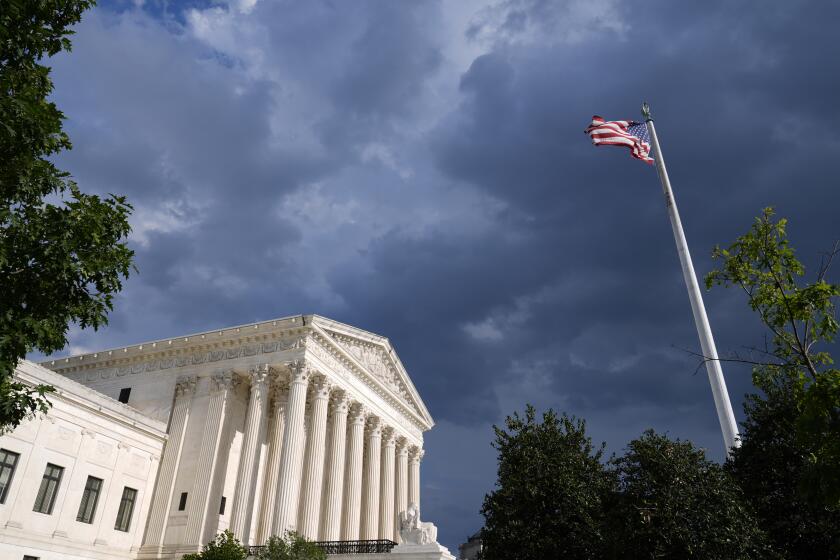Newsletter: One Kavanaugh battle ends, another is just beginning
- Share via
The nation’s Supreme Court will soon officially be back at full strength, after an unprecedented confirmation process that is likely to leave lasting scars on the politics and culture of the nation for years to come.
Brett Kavanaugh was confirmed by the Senate on Saturday and is expected to formally join the high court on Tuesday. But the story that has played out over the past few weeks is far from over.
KAVANAUGH: THE OATH, THE PROMISE FROM DEMOCRATS
The nation’s 114th Supreme Court justice took the oath of office on Saturday night, hours after the closest confirmation vote in modern American history.
Demonstrators had been gathered in front of the Supreme Court building, with some critics insisting the day’s events be seen as a partisan message about women.
“Republicans are saying: your voices just don’t matter,” Sen. Patty Murray (D-Wash.) said Saturday. “Your experiences, your trauma, your pain, your heartache, your anger — none of that matters.”
And yet Washington’s minority party must walk a narrow line in the weeks to come, as it seeks to use anger as an electoral catalyst while not turning the midterms into a polarizing referendum on whether the new justice should be impeached.
One thing seems quite clear, as David Savage points out: Kavanaugh may be taking a seat occupied for three decades by Justice Anthony Kennedy, but he will not fill Kennedy’s spot as a swing vote who sometimes joined the court’s liberal wing.
Sign up for the Essential Politics newsletter »
DECISION CALIFORNIA: FOUR MORE WEEKS
Democrats running in some of the state’s battleground congressional districts stood shoulder to shoulder with former Vice President Joe Biden last week, who lashed out at what he called the Republican Party’s “cultish devotion” to Trump.
“Lies have never been more brazen. Blind rage and brute partisanship has never been more palpable,” Biden said in an Orange County event featuring Democrats running in four of the area’s closely watched races.
Republicans are far from out of the running in those races. In the state’s 39th Congressional District, GOP contender Young Kim offers a familiar story to communities with large immigrant populations. Still, talk of the president is ever-present.
“I try to tell them I’m not running to be his spokesperson or represent Donald Trump in the White House,” Kim said.
Nearby, in California’s 48th Congressional District, Rep. Dana Rohrabacher‘s involvement with several figures in the special counsel investigation of Russian interference in the 2016 presidential campaign has put him in a fight for his political survival.
And as Democrats continue to post large fundraising numbers, the congressional races are likely to affect more than just Washington. My weekend column examines the likelihood of a domino effect in races for the Legislature that would hardly be competitive were it not for the fact those districts overlap the congressional contests.
NATIONAL LIGHTNING ROUND
-- A southern Minnesota television reporter who wore a “Make America Great Again” hat to a Trump rally that he was covering has been fired.
-- Secretary of State Mike Pompeo concluded a “productive” meeting with North Korean dictator Kim Jong Un, calling it another “step forward” in torturous talks to dismantle the nation’s nuclear arsenal.
-- Vice President Mike Pence laid out an increasingly confrontational approach to Beijing in a speech last week.
NEXT CALIFORNIA: MORE SENIORS, MORE COSTS
California has spent most of its modern history as a state teeming with young adults and families, providing fuel to its economy and culture in ways that have changed the country.
But its story in the 21st century is one of aging — the Golden State is getting more gray, in ways that will test its system of government services and its top elected leader.
In Part 3 of our series on the Next California, Melanie Mason offers a glimpse of just how big the challenge will be. And as in previous installments, candidates Gavin Newsom and John Cox offer their take on how to prepare for an older Golden State.
TODAY’S ESSENTIALS
-- California’s two premier political contests this election season have at least one thing in common — a dearth of debates. Voters deciding on a governor and U.S. senator will have only one opportunity to catch the candidates debating the issues.
-- No matter who wins in November, the next governor won’t resemble most Californians. In a state where Latinos outnumber whites, women outnumber men and the median family income is just under $64,000 a year, both gubernatorial candidates are white men who earn more than a $1 million a year.
-- The president of the board of administration of CalPERS, the state’s largest public employee pension fund, lost her bid for reelection to a Corona police officer.
-- With officials now looking into every way possible to open up Hollister Ranch, many have asked: How exactly did 8.5 miles of California’s most pristine coastline remain so private — and with so little scrutiny — for four decades?
LOGISTICS
Essential Politics is published Monday and Friday.
You can keep up with breaking news on our politics page throughout the day. And are you following us on Twitter at @latimespolitics?
Miss Friday’s newsletter? Here you go.
Please send thoughts, concerns and news tips to politics@latimes.com.
Did someone forward you this? Sign up here to get Essential Politics in your inbox.
More to Read
Get the L.A. Times Politics newsletter
Deeply reported insights into legislation, politics and policy from Sacramento, Washington and beyond. In your inbox twice per week.
You may occasionally receive promotional content from the Los Angeles Times.










